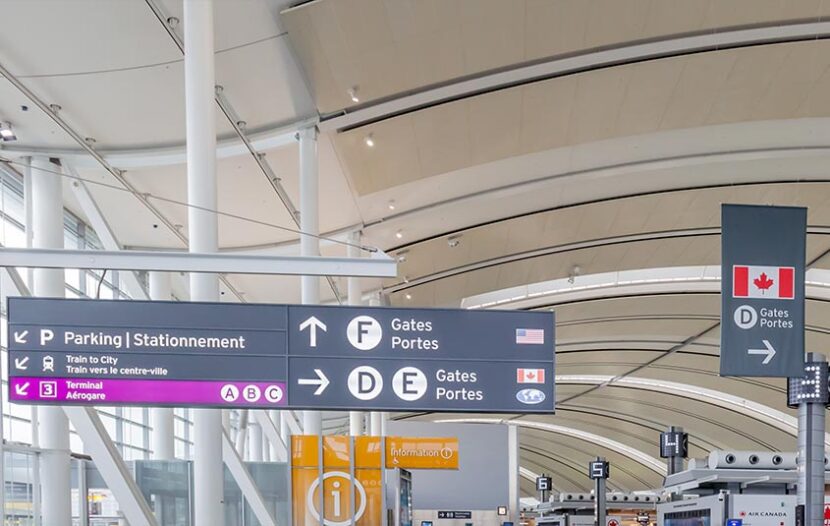TORONTO — All the analytics are heading the right direction as the Canadian travel industry’s recovery picks up more momentum.
The latest stats from the federal government show that for the week of Sept. 19-25, 97% of flights planned for Canada’s top four airports were completed (i.e., not cancelled). That’s just about on par with almost the same period three years ago (Sept. 23-29, 2019), when 98% of flights for the top four airports were completed.
A higher proportion of flights are leaving on time too, or at least what the government defines as ‘one time’ (i.e. within one hour of their scheduled departure). From Sept. 19-25, 2022, over 90% of flights from the top four airports left within one hour of their scheduled departure. That’s an improvement from under 75% for the first week of July and is approaching the pre-pandemic levels in September 2019 where 95% of flights were on time, or within an hour of scheduled departure.
Passenger security screening wait times are also down. From Sept. 19-25, 2022, 91% of passengers at the four largest airports were screened within 15 minutes by CATSA, an improvement from 79% during the first week of July 2022.
- Toronto-Pearson International Airport: 94% (vs. 99% in 2019)
- Vancouver International Airport: 91% (vs. 90% in 2019)
- Montréal-Trudeau International Airport: 94% (vs. 98% in 2019)
- Calgary International Airport: 81% (vs. 86% in 2019)
Meanwhile the number of arriving international flights being held on the tarmac at Toronto Pearson International Airport has decreased dramatically since May. For the week of Sept. 19-25, 2022, 1.2%, or 25 international flight arrivals, were held on the tarmac, as compared to the peak of 373 during the first week of May.
With the last of Canada’s COVID-19 travel restrictions and mandates eliminated as of tomorrow, Oct. 1, 2022, the head of a union representing Canada’s customs and immigration officers says chronic staffing shortages mean long waits at the border won’t necessarily disappear when use of the ArriveCAN app soon becomes optional.
Even with those concerns, after more than two and a half years of COVID restrictions travel advisors Travelweek spoke to couldn’t be happier with the changes coming Oct. 1.
Effective tomorrow …
- Travellers will no longer be required to undergo health checks for travel by air and rail;
- Travellers will no longer be required to wear a mask for travel on planes and trains, though it is strongly recommended to help prevent the spread of COVID-19
- Passengers and crew onboard cruise ships will no longer be subject to vaccine requirements or testing before they board a vessel;
- Airlines will no longer need to review the vaccination status of foreign nationals or confirm travellers have submitted the required information in ArriveCAN;
- Airlines will no longer need to ensure compliance with pre-entry testing requirements;
- Testing, quarantine, and isolation requirements for anyone entering Canada is no longer required, including mandatory random testing.
SKYSCANNER DATA
Heading into what will no doubt be a busier-than-ever booking season for the Canadian travel industry, we checked in with Skyscanner to ask about booking trends from this market.

Mark Crossey
Analyzing Skyscanner’s metasearch travel booking data from Canada, Mark Crossey, Director of Sales, Skyscanner Americas, noted that 30% of bookings are for a week or less. And monthly booking volumes are trending upward, with a 4% increase in September vs. August.
Top destinations for Canadians booking travel departing in the short term (before the end of 2022) range from New Delhi to New York, Calgary, Vancouver and London.
We asked Crossey, with Oct. 1 very close on the horizon, what are Skyscanner’s predictions for bookings by Canadian travellers in the days and weeks ahead?
”The last few years have demonstrated that amid complexity, Canadians still care deeply about the experiences and interactions afforded by travel. This latest move to remove extra complexity comes as attentions turn to the holidays as well as the year ahead and will encourage people to make travel plans to look forward to. Providers will be eager to ensure pricing is competitive to continue to rebuild confidence and get people back to the places they love,” he said.
Speaking of prices, we also asked Crossey about airfares for Canadian travellers.
“The primary driver for the cost of airfare has always been – and remains – demand and supply,” he says. “Traveller demand is returning to near pre-pandemic levels with some routes already seeing even higher interest than before the pandemic. This strong demand is meeting and sometimes outpacing available seats, which causes higher prices for tickets. Smart travellers are shopping around, finding great deals using flexible search parameters. Prices may be rising in places, but not on every route, and not at the same rate, which means there are still incredible deals to be found for travellers who can be flexible.”
Got a story idea? Reach out to Editor Kathryn Folliott at kfolliott@travelweek.ca

